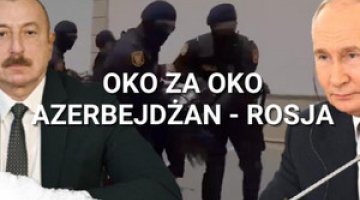Fragile truce in the Caucasus: Yerevan’s lsolation, Baku’s assertiveness
On September 14 at 6 p.m. CET, Armenia and Azerbaijan agreed on a ceasefire that brought an end to the intense fighting that had begun two days earlier. So far, the ceasefire has been observed, although the situation in the conflict area remains very tense. According to official data, 105 Armenian and 71 Azerbaijani soldiers were killed as a result of clashes and shelling. Armenian Prime Minister Nikol Pashinyan also reported that Azerbaijani forces had occupied 10 km2 of Armenian territory. On 14 and 15 September, a crowd of thousands gathered in front of the parliament in Yerevan demanding the impeachment of the prime minister who, according to demonstrators, had betrayed the nation (this referred to his suggestion that he would sign a peace treaty with Azerbaijan). The opposition has announced that government buildings will be blocked in the coming days.
Armenia has appealed to the Collective Security Treaty Organization (CSTO) to apply Article 4 of the Collective Security Treaty (aggression against one state will be seen as an attack on all its members, casus foederis) since a direct attack on its territory was launched. The CSTO is dominated by Russia and has not decided to send a military mission to the area of the clashes, opting to only send an ‘operational group’ to the Caucasus to examine the situation on the scene. Moscow’s official reaction was limited to an appeal to stop fighting. Turkey strongly supported Azerbaijan, while Iran announced it would react in case Iranian transit through Armenia is put at threat. The Azerbaijani-Armenian clashes are also being discussed at the UN Security Council.
Commentary
- The current crisis is the most serious since the end of the Second Karabakh War in November 2020. Although an escalation of tension has recurred on a regular basis since that time (for example, in March and August this year), the clashes were local and not on such a large scale—usually several soldiers were killed in them. Azerbaijan’s direct attack on targets in Armenia proper, outside the region of the Nagorno-Karabakh conflict, was a new development. It is still unclear why the situation has worsened so suddenly. An unprovoked attack by Baku cannot be ruled out nor can provocation by Armenia resulting in Azerbaijan responding disproportionately to the strength and scale of the attack. However, as during previous escalations, Baku’s goal was most likely to force Yerevan to sign a peace treaty as soon as possible that would satisfy Azerbaijan’s expectations regarding the confirmation of its territorial integrity, and to delineate a corridor to Nakhchivan and Turkey. Unless Baku’s demands are satisfied soon, it will most likely continue to put pressure on Yerevan and over time it may also attempt to seize the Armenian-controlled part of Nagorno-Karabakh with Stepanakert (Khankendi – Xankəndi in Azerbaijani). However, such an operation would entail the risk of a new war, which Baku does not want, as it would threaten existing and planned infrastructure investments.
- The crisis has further worsened the Armenian government’s dilemma regarding the settlement of the Nagorno-Karabakh conflict. It seems that Prime Minister Pashinyan is convinced that it is necessary to conclude a peace treaty with Azerbaijan and to normalise relations with Turkey: since Russia has failed to fulfil its obligations as an ally, this is the only way to give Armenia a chance for peace and stability and the prospect of economic development (as a result of opening its borders with its Turkic neighbours). If the talks and the peace process are prolonged, tensions are likely to further escalate, regardless of the need to agree on a whole range of technical issues. In the worst-case scenario, the country may lose part of the territory in the south (the region of Zangezurn). On the other hand, the signing of a treaty will certainly provoke violent protests within the country, which may lead to the overthrow of the government. The ruling elites in Nagorno-Karabakh, who are associated with the former presidents of Armenia Robert Kocharyan and Serzh Sargsyan, remain opposed to Pashinyan (on 15 September the leadership of this para-state travelled to Yerevan for consultations). The prime minister cannot be confident of the loyalty of some of the Armenian army’s commanders (if the current crisis was really provoked then these circles were responsible for it).
- Recent events have highlighted Yerevan’s isolation in the international arena and Baku’s freedom to act. Western politicians have voiced support for Armenia. For example, the US Secretary of State de facto concluded that Azerbaijan was to blame for the recent escalation. During his conversation with President Ilham Aliyev, he called on him to immediately stop hostilities and withdraw Azerbaijani armed forces from the border region. In addition, Nancy Pelosi, the speaker of the House of Representatives, is expected to arrive in Yerevan this weekend. However, this does not compensate for Russia’s failure to provide help – during the war in 2020 Moscow argued it did not help Armenia because the fighting took place de jure in Azerbaijan, but now Armenia has been attacked and still cannot count on its Russian ally. In turn, the EU and its individual member states will most likely avoid straining relations with Baku, as they are counting on an increase in supplies of Azerbaijani gas. However, a sharp response from Iran to attempts to change the status quo by force, including the shape of internationally recognised national borders, cannot be ruled out. It seems that Russia, due to its involvement in Ukraine, is not able to intervene in the Caucasus on a large scale. The fact that Russia has not reacted even symbolically – it should be noticed that the Azerbaijani shelling damaged the building and equipment used by the Russian border troops (which are part of the Federal Security Service) – proves that it is unwilling to take any action, despite the fact that this harms its prestige. It is possible that Russia has taken this approach because it wants to maintain good relations with Ankara while under Western sanctions.
Map. The Nagorno-Karabakh conflict area. 13–14 September 2022 crisis






